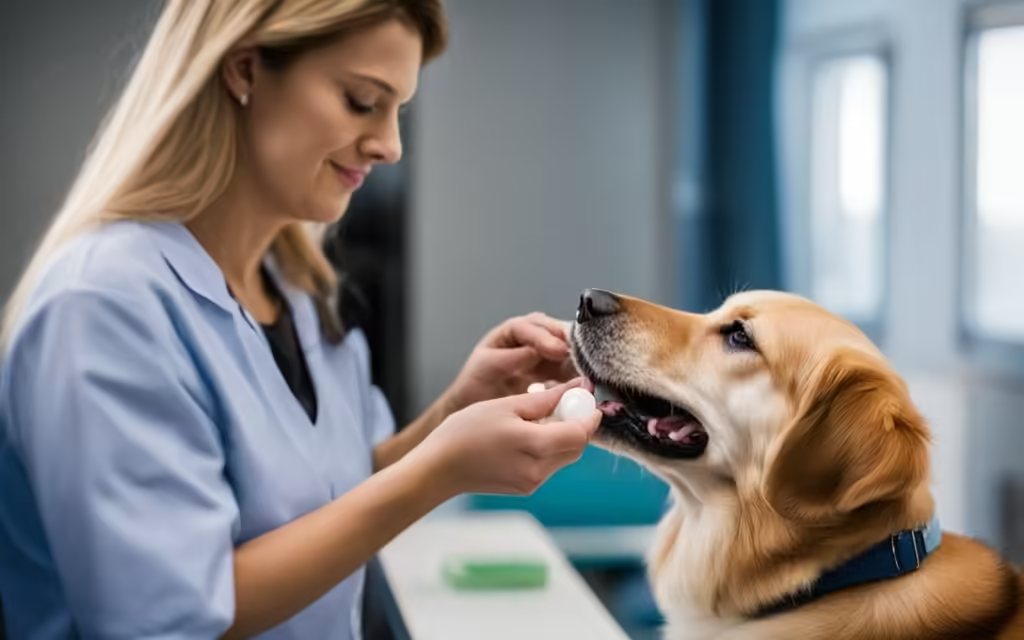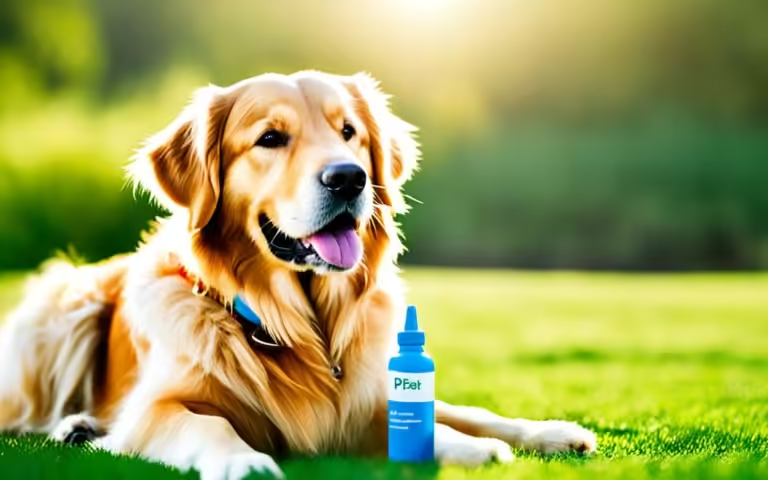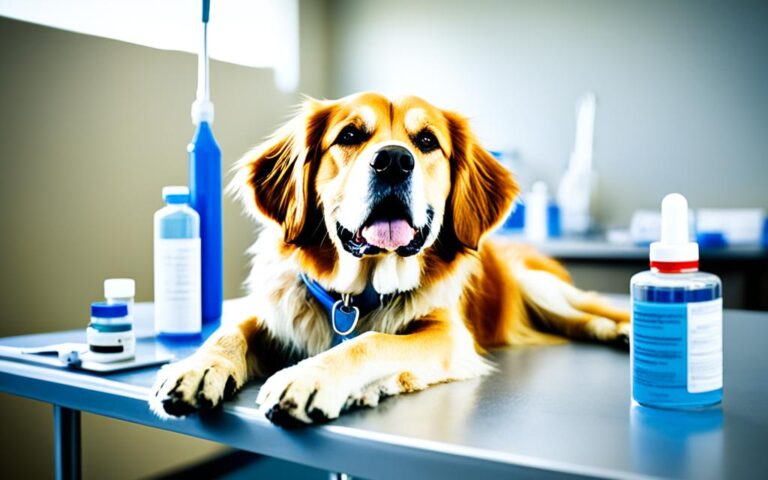Lorazepam for Dogs: Uses and Safety Guidelines
Did you know that lorazepam is often given to dogs with emotional issues1? This drug is key in helping dogs with anxiety, seizures, and other problems. It’s important for pet owners and vets to know how to use lorazepam safely and correctly2.
Key Takeaways
- Lorazepam is a benzodiazepine medication used to manage anxiety disorders and seizures in dogs.
- Recommended dosages for lorazepam in dogs range from 0.01-0.1 mg/kg PO1.
- Lorazepam may be administered orally, intramuscularly, or intravenously, depending on the clinical situation.
- Potential side effects include sedation, ataxia, and paradoxical excitement.
- Careful monitoring and screening are essential for dogs on long-term lorazepam therapy.
Understanding Lorazepam for Canine Use
Lorazepam belongs to the benzodiazepine class of drugs. It works as a Canine CNS Depressant by boosting the effects of gamma-aminobutyric acid (GABA) in the brain3. This makes lorazepam a key Benzodiazepine Sedative in vet medicine4.
What is Lorazepam?
Lorazepam is a Veterinary Psychoactive Medication that quickly gets into dogs and has a short half-life of about 0.9 hours5. Studies show it works just as well as diazepam in stopping seizures in dogs5.
Mechanism of Action and Pharmacology
Lorazepam boosts certain brain chemicals, causing sedation and reducing anxiety3. Dogs absorb lorazepam well through the mouth, and it can be given in different ways like IV, IM, intranasal, and rectal5.
Giving lorazepam through the nose at 0.2 mg/kg quickly got it into the bloodstream, keeping it effective for an hour5. A study found giving lorazepam through a vein didn’t make a big difference in stopping seizures compared to giving diazepam that way5.
“Lorazepam is a short-acting medication that takes effect in about 30-60 minutes.”3
Lorazepam’s effects make it a great choice for vets treating dogs. We’ll look more into this in the next sections.
Indications for Lorazepam in Dogs
Lorazepam is a benzodiazepine that vets use for many dog health issues. It’s great for Treating Canine Anxiety and Managing Dog Seizures6.
Anxiety Disorders
Dogs can feel anxious for many reasons, like being left alone or scared of loud noises. Lorazepam helps calm them down and ease their anxiety. About 14 percent of dogs have separation anxiety6.
Combining Lorazepam with training can help manage their anxiety6. Vets might give Lorazepam before events that make dogs anxious, like storms or fireworks7. This helps reduce their stress and keep them calm.
Seizure Control
Lorazepam is also used for dogs with seizures, but not as much as other drugs. Studies show it works as well as diazepam for seizures in dogs6.
If a dog has a long seizure, Lorazepam injections can help stop it fast7. It’s important to have this medicine ready for emergencies.
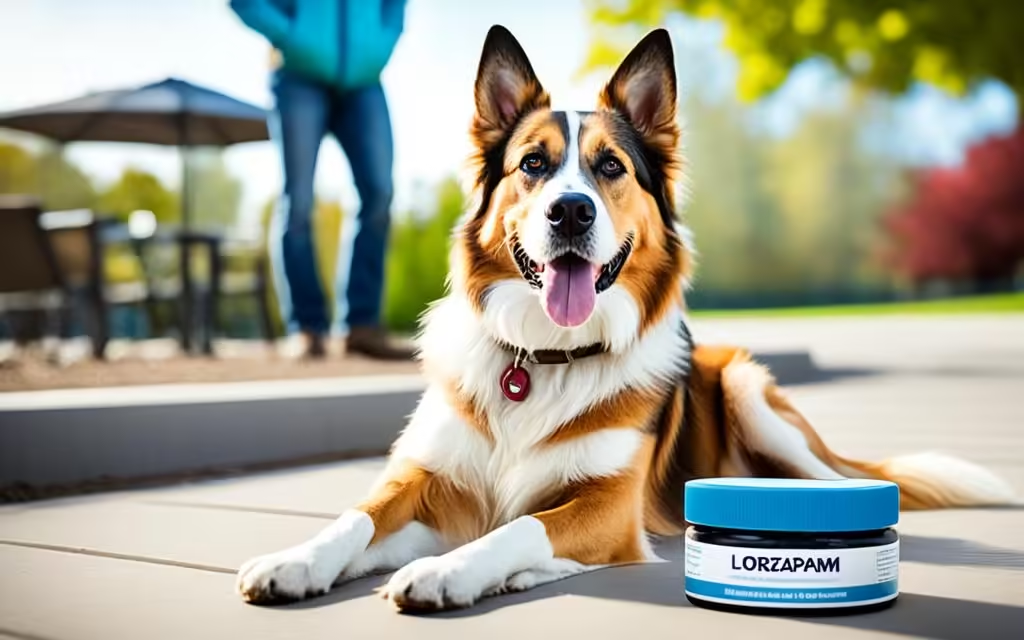
Remember, use Lorazepam only with a vet’s guidance. Long-term use can make dogs dependent on it, needing careful withdrawal7. Dogs on Lorazepam need regular vet visits to check their progress and adjust the treatment678.
Lorazepam for Dogs: Uses and Safety Guidelines
Lorazepam, a benzodiazepine medication, can help dogs with certain conditions when a vet guides its use9. It can ease anxiety caused by things like thunderstorms or fireworks, or help with separation anxiety and fear of the vet9.
But, it’s key to follow the vet’s advice on dosage and how to give it to your dog9. Vets will pick the right Lorazepam dosage and way to give it, based on the dog’s needs and health9.
- Some dogs never need a sedative, but others might have ongoing anxiety that affects their safety and happiness10.
- Dogs with anxiety might show fear by trying to escape, or they could be very nervous, panting, pacing, or even trembling10.
- Helping a dog with anxiety often means training them to be less scared, along with the right medicine to calm them for training10.
When using Lorazepam, watch your dog for signs of sedation, more hunger, clumsiness, or more activity and aggression9. Vets might suggest other treatments or medicines to use with Lorazepam to keep your dog safe and calm10.
“Finding the right sedative for a dog can take some trying, as each dog reacts differently to stress and medication.”10
With a vet’s help and by following safety rules, pet owners can use Lorazepam safely and effectively to help their dogs91011.
Administering Lorazepam to Dogs
Lorazepam is a strong medicine used for dogs with anxiety or seizures7. It comes in tablets, liquid, or injection forms7. The right amount and how often you give it depends on the dog’s condition and how it reacts to the medicine7.
Dosage and Frequency
Dogs taking lorazepam usually get it once or twice a day7. Vets might start with a small dose to see how the dog reacts, then adjust as needed9. Lorazepam works for about two to twelve hours in dogs9.
Routes of Administration
Dogs can get lorazepam through tablets, liquids, or injections7. Taking it by mouth is the most common way7. In emergencies, like long seizures, vets might use injections7.
Remember, there are no special dog medicines with lorazepam, so vets might use human ones7. It’s key to follow the vet’s advice closely to use lorazepam safely and effectively in dogs7.
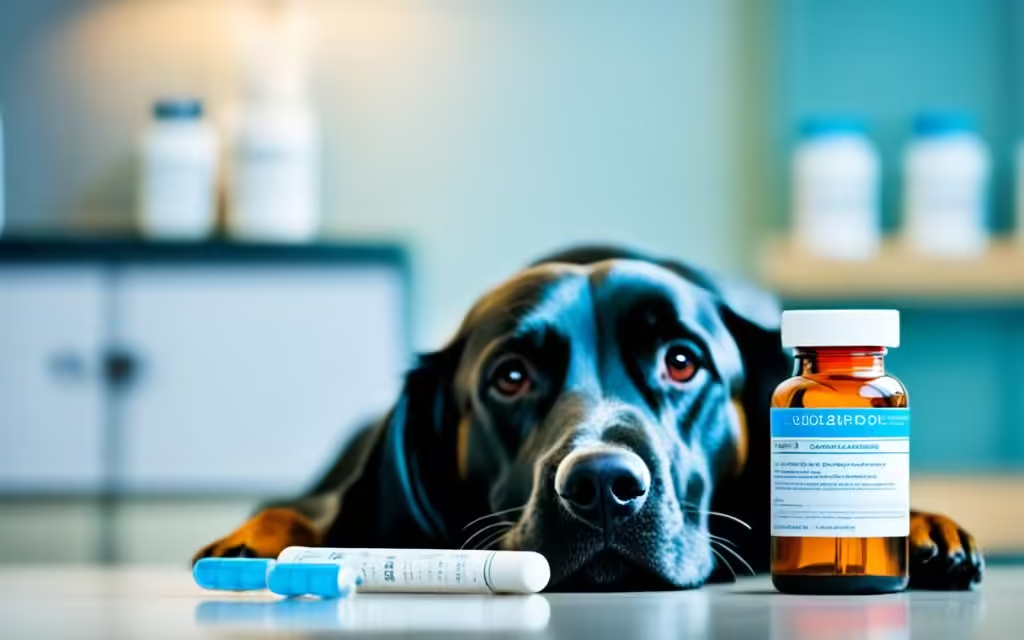
Give lorazepam to dogs as the vet says, and tell them about any bad reactions right away7. Keeping lorazepam safe, handling it right, and getting rid of it properly is important for the dog and the owner’s safety7.
“Lorazepam is a powerful medication that requires close monitoring and management by a veterinary professional to ensure the best possible outcome for the dog.”
Potential Side Effects of Lorazepam in Dogs
Using lorazepam in dogs can lead to side effects12. This drug is often given to help with serious issues like fear during thunderstorms. But, it can cause problems if not used right or if dogs eat it by mistake12.
Sedation is a common issue in dogs taking lorazepam12. They might seem dizzy, weak, and not steady12. In some cases, dogs could have trouble breathing or even have seizures12. This happens if the dose is too high or given too fast12.
It’s important for dog owners to watch their pets for any bad reactions12. If you see any, tell your vet right away12. Getting help quickly is key because benzodiazepine poisoning can be very serious12. Treatment might include making the dog vomit, giving activated charcoal, and giving supportive care12.
| Medication | Typical Dosage Range | Potential Side Effects |
|---|---|---|
| Lorazepam | 0.02-0.1 mg/kg q8-24h13 | Sedation, dizziness, weakness, unsteadiness, disorientation, respiratory difficulty, seizures12 |
| Fluoxetine | Maximum plasma levels reached in 1.8 hours13 | Lethargy, anorexia13 |
| Paroxetine | N/A | Lethargy, anorexia13 |
| Gabapentin | 5-30 mg/kg up to three times daily, or 10-40 mg/kg up to three times daily14 | Sedation, ataxia, gastrointestinal distress, increased anxiety, agitation14 |
The outcome for dogs with benzodiazepine poisoning depends on how much they took and how they react to treatment12. With quick vet care, many dogs can get better from lorazepam and other benzodiazepines12.
“Veterinarians and pet owners must remain vigilant in monitoring for any adverse reactions to lorazepam and other medications used in canine patients. Early detection and appropriate management are crucial to ensuring the safety and well-being of our canine companions.”
Precautions and Contraindications
Vets must be careful when giving lorazepam to dogs. They need to think about a few key things15. For example, they should not use lorazepam on pregnant or nursing dogs. We don’t know much about how it affects their babies or puppies16. They also need to check if lorazepam will work well with other medicines the dog is taking. Lorazepam can mix badly with many drugs16.
Pregnancy and Lactation
It’s not a good idea to give lorazepam to pregnant or nursing dogs. It might cause birth defects or make newborn puppies have withdrawal symptoms16. Vets should think hard before giving it to these dogs.
Interactions with Other Drugs
Lorazepam can mix badly with many medicines vets use16. This can make dogs sleep too much, breathe too slowly, or have other bad reactions. Vets need to watch out for this and might need to change the dose.
“The use of benzodiazepines, including lorazepam, may lead to potentially fatal respiratory depression.”16
Before giving lorazepam, vets should check what other medicines the dog is taking. This helps make sure the medicine works right and is safe.
Knowing about the risks of lorazepam helps vets make smart choices. They can keep their patients safe and healthy151617.
Stability and Storage of Lorazepam
Storing lorazepam right is key to keeping it effective for dogs18. This drug comes in 0.5 mg, 1 mg, and 2 mg tablets18. It reaches its peak effect in 2 hours, lasting from 1-6 hours18.
Keep lorazepam in a sealed container away from light, at room temperature18. The injectable form mixes well with some solutions but discard any that looks off18. Lorazepam stays in your system for 12 to 15 hours, with some parts lasting 16 to 20 hours18. About 85% of it sticks to plasma proteins18.
A study found differences in how two lorazepam types worked18. Keeping lorazepam right is key for its effectiveness in dogs18. Following storage and handling tips keeps the medicine safe for dogs18.
Vets must handle and store lorazepam correctly for their dogs’ safety181920.
Comparing Lorazepam with Other Benzodiazepines
Lorazepam, also known as Ativan, is a benzodiazepine used for anxiety and seizures in dogs. But it’s not always the top choice21. Diazepam and alprazolam are more commonly used in vet medicine21. When picking a benzodiazepine, consider how well they work, their cost, and possible side effects21.
Efficacy and Cost Considerations
Benzodiazepines work fast, easing anxiety in 30 to 60 minutes21. They last from 2 to 12 hours, with cheaper options being shorter-acting21. Lorazepam comes in 0.5 mg, 1.0 mg, and 2.0 mg forms, plus a 2 mg/ml solution22. Oxazepam is in 10 mg, 15 mg, and 30 mg forms22.
The right dose for dogs is 0.02-0.5 mg/kg every 12-18 hours for lorazepam22. For oxazepam, it’s 0.04-1.0 mg/kg every 6 hours22. These dosages affect the cost of treatment for pet owners.
Side Effect Profiles
Sedation is the main side effect of benzodiazepines, with others like muscle relaxation and increased appetite21. Lorazepam is good at reducing anxiety without making a dog too sleepy22. Oxazepam has a bigger gap between its helpful and side-effect doses22.
It’s important to watch how often pets get refills on benzodiazepines to prevent misuse or addiction21. These drugs can be addictive in humans and pets if used too much or for too long21.
Vets must think about how well a benzodiazepine works, its cost, and side effects when choosing one for a dog21. Knowing what makes each benzodiazepine different helps vets make the best choice for the dog’s health212223.
Essential Drug Information
Lorazepam, also known as Ativan, is a type of sedative and anti-anxiety drug for dogs24. It’s often used to help dogs with anxiety, seizures, and other behavioral problems24.
Understanding Lorazepam is key for pet owners and vets. This drug is approved for pets and works by boosting a brain chemical called GABA. This helps calm dogs and reduce anxiety24.
- Common Names: Lorazepam, Ativan
- Drug Type: Benzodiazepine sedative and anti-anxiety medication
- Used For: Anxiety disorders, seizure control in dogs
- Administered: Tablets, oral liquid, injectable
- FDA Approved: Yes
Lorazepam is a key medicine for dogs with many behavioral and health issues24. It works fast and doesn’t last too long, making it great for short-term anxiety like vet visits24. Vets often use it with other treatments or behavior training to help dogs fully24.
Knowing about Lorazepam Drug Details for Dogs helps vets and pet owners make smart choices for their pets24. Always follow a vet’s advice and watch how your dog reacts to the medicine for safety and best results24.
“Lorazepam is a valuable tool in the veterinary arsenal for managing a wide range of canine behavioral and medical conditions.”
Monitoring Dogs on Lorazepam Therapy
When a dog gets lorazepam, it’s key for the owner to watch them closely. They should look out for signs of being too sleepy, dizzy, or any other side effects25. Lorazepam is usually safe, but it’s important to check in with the vet often to see how it’s working and adjust the dose if needed25.
It’s vital to keep an eye on your dog while they’re on lorazepam. If you notice any changes in their behavior or health, tell the vet right away25. This helps the vet check on your dog and make the right choices about their medicine.
Following up closely with your vet is key when your dog is on lorazepam. They might suggest physical checks, blood tests, and watching how your dog acts to see how the medicine is working26. Before starting the medicine, tests like a blood chemistry panel, urine test, and complete blood count (CBC) are often done26.
By watching your dog closely and talking with your vet, you can make sure they’re doing well on lorazepam25. Working together with your vet is important to make sure lorazepam helps your dog without causing any problems.
In short, watching dogs on lorazepam means regular vet visits, keeping a close eye on them, and telling the vet about any issues. This helps make sure the medicine is working right, keeping your dog healthy and happy.
Conclusion
Lorazepam can help dogs with anxiety and seizures27. It’s often used in vet medicine for its calming effects27. But, it’s important to use it as directed to keep your dog safe and well28. Things like liver issues can change how lorazepam works in a dog’s body28.
Vets and pet owners work together to find the right treatment for your dog29. They consider the dog’s size and other medicines it might take29. This helps make sure lorazepam is used safely and effectively.
Using lorazepam can be a big help in vet care when done right29. With the right guidance from a vet, it can really help your dog.
FAQ
What is Lorazepam and how does it work for dogs?
What are the common uses of Lorazepam in dogs?
How is Lorazepam administered to dogs?
What are the potential side effects of Lorazepam in dogs?
Are there any precautions or contraindications for using Lorazepam in dogs?
How should Lorazepam be stored for canine patients?
How does Lorazepam compare to other benzodiazepines used in veterinary medicine?
What should pet owners do when their dog is prescribed Lorazepam?
Source Links
- The Use of Medications in Canine Behavior Therapy
- Lorazepam for Dogs
- Lorazepam | VCA Animal Hospitals
- Lorazepam – an overview | ScienceDirect Topics
- Broadway Animal Hospital
- Pet Factsheets – Crossriggs Veterinary Clinic
- Benzodiazepines
- Benzodiazepines For Dogs (Types, Side Effects & Safety) | Dutch
- Dog Sedatives: When and How to Use Them | Bond Vet
- 10 Medications for Dog Anxiety
- Benzodiazepine Medication Toxicity in Dogs
- Canine & Feline Anxiety – VIN
- The use of gabapentin to help manage anxiety in dogs
- *
- Microsoft Word – ~db5_O0e22079cfb484762a9f6c9b4b1365d75.doc
- Northgate Veterinary Clinic
- Microsoft Word – ~db5_O6acf0f459efc4257a3123d2dc7acfb8d.docx
- Loreev XR
- Untitled
- Layout 1
- Benzodiazepines: pros and cons (Proceedings)
- Ativan (lorazepam): Side effects, dosage, uses, and more
- Anti-Anxiety Medications for Dogs – Whole Dog Journal
- Which Drugs Are Used to Treat Cognitive Dysfunction Syndrome?
- Behavior Counseling – Medications and Consent Form | VCA Animal Hospitals
- Psychopharmacology – WSAVA 2015 Congress
- Hepatic and extrahepatic glucuronidation of lorazepam in the dog – PubMed
- Lorazepam – an overview | ScienceDirect Topics

